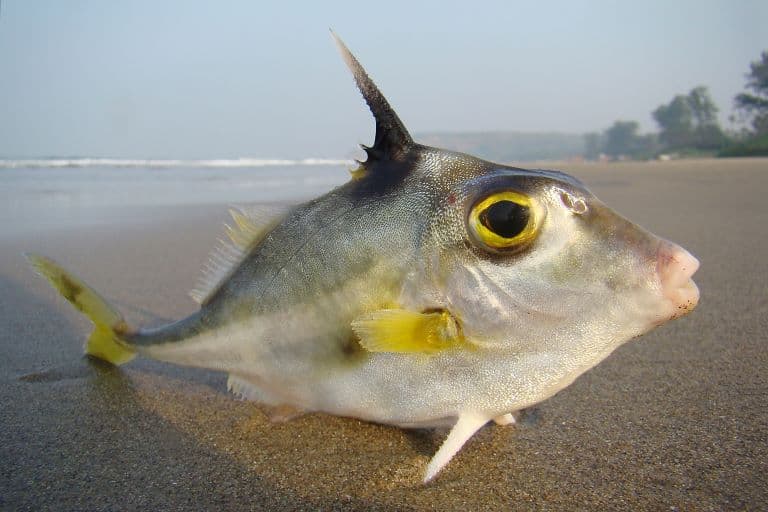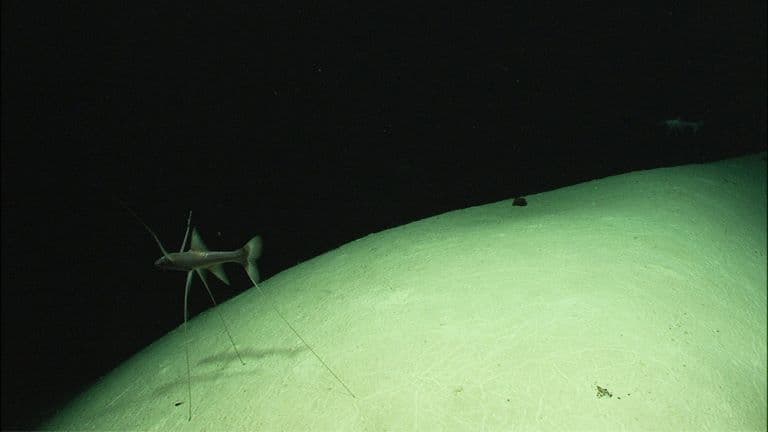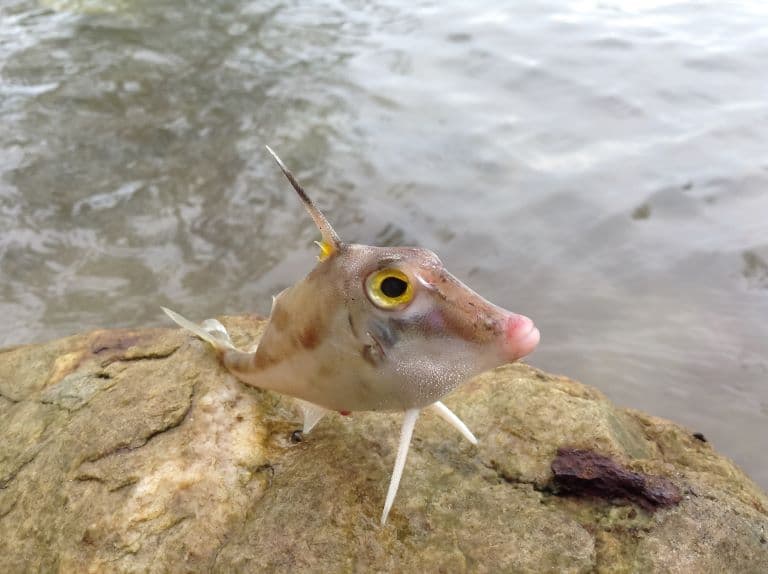Tripod Fish Profile
When you’re an animal fan, it can be frustrating to observe the fervent search for extra-terrestrials and the desperate urge by the public for something new and exciting; something alien and weird from a world so different from ours.
And this frustration grows when people start spending copious amounts of money on searching the inhospitable vastness of space while entirely neglecting our own alien worlds just a few kilometres beneath us.
The deep sea has all of the wonder and none of the hopeless fictionality. A great example of this is the Tripod fish, an animal that comes straight out of an HG Wells book and has been there in the ocean the whole time.

Tripod Fish Facts Overview
| Habitat: | |
| Location: | |
| Lifespan: | |
| Size: | |
| Weight: | |
| Color: | |
| Diet: | |
| Predators: | |
| Top Speed: | |
| No. of Species: | |
| Conservation Status: |
Tripod fish have been found as deep as 6km into the ocean. They’re one of the deepest-living fishes, and as such have adjusted to this alien world by forming a bunch of strange adaptations, many of which are more reminiscent of legged arthropods like crabs.
Interesting Tripod Fish Facts
1. They perhaps want to be crabs
A strange quirk of evolution has shown that crablike morphologies have evolved independently at least five different times. This phenomenon, known as carcinization, demonstrates the effectiveness of the crab body in ocean environments.
It’s so good at what it does that animals keep evolving toward a crabbier appearance (and possibly temperament) as a way of becoming better suited to their environment.
This phenomenon usually refers to crustacean evolution, but the tripod fish may represent a bit of an analogue of this, as it’s been able to evolve a series of adaptations more commonly found in crabs.
And this is no small feat because there are quite a few things found on crabs that aren’t found on fish at all.
2. They have no legs
Unlike crabs, fish have no legs. Unless of course you count Michael Fish, the longest-serving weatherman on British television, but he is by all accounts, an exceptional specimen.
For the most part, legs in ocean animals are found only in arthropods, so if a fish were to desire such luxuries as standing up, they’d have to come up with something very clever to compensate for this lack.
And that’s exactly what the tripod fish has done. Instead of evolving legs, it’s managed to change the shape of the appendages it already has and consequently is capable of resting on elongated fins.
The two pelvic fins and the lower tail fin have grown to exaggerated proportions – sometimes up to a meter long – and some suggest the fish is able to pump them full of fluid to maintain rigidity. As a result, they form a three-pointed stand, or tripod, upon which the fish can rest.

3. They have no antennae
Standing up is the first step to becoming a crab but without long wavy appendages to figure out what’s going on, you’re just going to be a fish with legs.
But fish don’t have antennae, so what to do? Well, the tripod fish has this figured out too. The elongating of the fins for standing worked out pretty well, so they elongated their pectoral fins too.
These exaggerated fins splay out with each ray of the fin occupying its own space. Unlike the stilts, these are better innervated for sensory input.
These fins are now capable of functioning as sensory antennae, as they’re waved around in the water column to detect signals from passing prey or approaching threats, and are said to aid in ushering the former toward the fish’s mouth.
And it’s a good job, too, because their vision sucks. 1 2
4. They can’t see
Living, as they do, in the deepest part of the ocean, there isn’t much natural light for their eyes to pick up, yet light is still important for a lot of animals down there.
Bioluminescence plays a big role in deep-sea communities as a way of finding food, mates, or even camouflaging oneself against the murk if at all any light can squeeze through at those depths.
But the tripod fish doesn’t seem to have any interest in all of this, and while many of its local peers have evolved enormous eyes to gather whatever scarce photons are available for processing, this fish’s eyes have grown small and ineffective over time, suggesting that light plays very little part in its life.
And this, you’d think, would make it tricky to reproduce in a world where there’s lots of nothing in between two individuals. And that’s probably true, but the tripod fish has another trick up its sleeve for that.

5. They can self-fertilise
Tripod fish appear to have both sets of sex organs. This is really handy when a suitable mate is hard to come by. If they aren’t able to get laid, they’ll give themselves a once over instead and can fertilise their own eggs.
This method is usually found in nature as a backup. Its advantages are clear: no need to find a mate, no need to buy anybody breakfast after, great for when the dating pool sucks. But there are disadvantages to this, too.
Reduced genetic diversity is the big one. Sex is a fantastic way of spreading out and reducing the impact of dodgy genetics and this benefit is lost when an animal reproduces asexually.
So, they must still benefit from finding a mate, and to do this, they need to be capable of doing more than just standing on their tripods waiting for The One. 3
6. They can still swim
One advantage that fish have over crabs is their ability to move rapidly through the water without looking stupid (sunfish excluded) and the tripod fish maintains this tradition.
Despite spending long periods entirely motionless, pinned to the spot on its gangly limbs, a meter off the ground, when push comes to shove, these fish are capable of bursts of speed and are competent swimmers.
If the fish is just moving a couple of meters away, it may not even move its dangly bits out of the way at all.
For longer journeys though, they tidy away nicely. The excessive extremities can tuck surprisingly close to the body and trail behind the fish as it makes its getaway.
This is an unexpectedly elegant motion for such a gangly-looking fish, but when it’s moved to a new location, they’ll extend the pelvic fins like landing gear, hold the tail fin out behind them, lowering it as support only after touching down. 4 5
7. They have big mouths
This is the key to understanding why the tripod fish is so weird. Filter-feeding is pretty rare in the fish community, but this example has figured it all out.
The deep sea is known for being cold, barren, and spread out. It’s not easy to find a lot of food down there, so energy conservation is key. And nothing conserves energy like refusing to move.
The trouble is, if you refuse to move in the deep, you get stuck in the “ooze” and must rely entirely on winning the whale carcass lottery to find food. There’s not much of a current across the dusty ocean bed, but there is once you hover about a meter above it.
And so, this big-mouthed, meter-tall tripod sits in the current with its mouth open, feeling around for passing plankton and other organic matter while barely lifting a finger. Again, a strategy far more commonly adopted in crustaceans than fish. 6
Tripod Fish Fact-File Summary
Scientific Classification
| Kingdom: | Animalia |
| Phylum: | Chordata |
| Class: | Actinopterygii |
| Order: | Aulopiformes |
| Family: | Ipnopidae |
| Genus: | Bathypterois |
Fact Sources & References
- Bec Crew, ”“Tripod fish: a deep-sea fish able to ‘stand’, Australian Geographic.
- KENNETH J. SULAK (Year), “THE SYSTEMATICS AND BIOLOGY OF BATHYPTEROIS”, Rosenstiel School of Marine and Atmospheric Science.
- Lev Fishelson (2001), “Ichthyology & Herpetology”, American Society of Ichthyologists and Herpetology.
- “Tripod Fish”, snotr.
- Matthew P. Davis (2011), “Tripodfish (Aulopiformes: Bathypterois) locomotion and landing behaviour from video observation at bathypelagic depths in the Campos Basin of Brazil”, Taylor & Francis Online.
- Deep Marine Scenes (2020), “Facts: The Tripod Fish”, YouTube.
